Are you riding around in a rust-riddled, corrosion-covered, pitting pile of automotive poo? Have your vehicle's protective undercoatings given-up the ghost, leaving your car's tender underbelly exposed to the elements? Sounds like it's time to apply some undercoating...
On the bright side, if you own a modern automobile, chances are you won't have to undercoat it all that often. Most cars today are constructed from lightweight, rust-resistant materials like aluminum, plastic, carbon fiber, and magnesium. This not only makes them far more fuel efficient and lightweight, but less susceptible to corrosive contaminants as well.
But that doesn't mean the modern automobile is immune either, which is precisely why all cars receive an undercoating at the factory, which in colder climates, requires routine cleaning and the occasional reinstallation.
However, a lot of car owners still don't know what undercoatings are made from, or how they work. Is there more than one kind of undercoating? Are there any health risks associated with this stuff? How often should a vehicle be undercoated?
Well fret no more, because today we'll be breaking down the good, the bad, and the rusty. As we dissect the latest undercoating solutions, and the pros and cons of this crucial layer of automotive protection.
What is the Undercarriage of a Car?
The undercarriage is every car's hidden foundation, one that guarantees smooth rides, safe stops, and stress-free performance. It typically consists of a chassis, suspension, steering, brakes, exhaust system, fuel, and protective shields.
However, depending on your car, you could also locate extra components, e.g., catalytic converters and drive shafts. That said, let’s explore what undercoating essentially stands for.
What is an Undercoating?
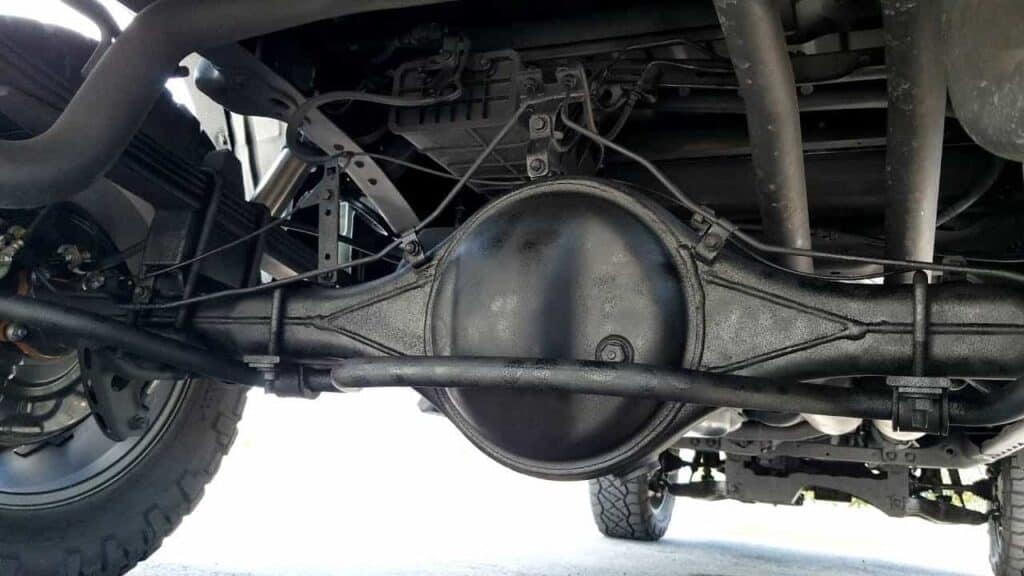
If you live in an area of the world that sees a significant amount of snow, or are located in a coastal region, you are probably are already familiar with the term "undercoating." For everyone else, here's a quick synopsis...
An undercoating is the first line of defense between an automobile's metallic underside and the elements, and all vehicles receive a coating of this stuff before rolling off the assembly line. But these OEM coatings will eventually wear-out over time, leaving oil pans, transfer cases, suspension arms, and other metal components vulnerable to corrosion and rust.
Most dealerships offer an additional undercoating as part of a "winter package" option, which typically consists of a "rubberized" media being sprayed across the vehicle's undercarriage. Once cured, this undercoating has the ability to repel rust and oxidation, rock chips, scratches, and even lower road noise levels.
But even if you purchase for this package option, or opt to tackle an undercoating application on your own, there's a still a good chance that your vehicle's underbelly is going to rust. There's a reason why automotive undercoatings have earned a reputation for being a bit of an unreliable, double-sided sword, and it's not because they don't work well.
Quick Tip: It is always best to apply an undercoating when you first purchase a brand-new vehicle, and not a few years down the road. It's far easier to coat the pristine underbelly of a vehicle with some additional armor, than it is to remove a crap-ton of road grime and gunk.
What Does Undercoating Look Like?
Typically, undercoating looks like a thick coating that resembles rubberized asphalt. Depending on the type of product used, the texture can vary slightly, from somewhat rough to relatively smooth. Nevertheless, it appears as either black or dark gray.
What Does Undercoating Do?
Many car owners wonder what undercoating does to a vehicle or how it helps. So this is for you!
Undercoating forms a protective layer between the undercarriage metal and environmental factors like moisture, salt, and road filth. Some undercoating compositions also include sound-dampening qualities. This can make driving quieter and more comfortable by reducing vibrations and road noise.
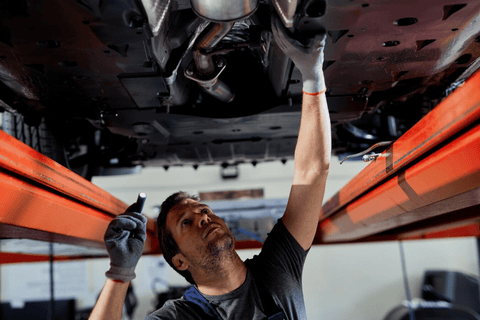
Is Undercoating Worth It?
Whether auto undercoating is a worthy investment for your vehicle depends on the following circumstances:
- Vehicle age and condition: Undercoating can help older vehicles or those with existing rust. However, it is not a substitute for proper rust repair.
- Climate and driving conditions: If you live in a location with high snowfall, heavy rains, or drive your car frequently for off-roading, undercoating can provide significant rust protection.
- Budget/DIY skills: Undercoating can be done professionally or as a DIY project. Applying undercoating professionally usually costs extra, but it guarantees correct technique and full coverage.
Is Oil Undercoating Worth It?
Oil-based undercoatings have many benefits. These solutions can penetrate small crevices and delay the growth of rust. Besides, some formulas can even self-heal minor punctures.
However, there are some downsides. For starters, their organic chemical compositions are an environmental hazard. Not to mention, they may drop over time in hot weather conditions and need to be reapplied. They might also not be as durable as other kinds, like rubberized coatings.
What's the Difference Between Undercoating and Rust Proofing?
If you've ever looked into protecting the underside of your automobile, chances are you've come across the terms "rustproofing," or "rust protection." Despite sounding identical, there are some key differences between these two methods of rust prevention, even if their intended purpose remains the same.
Rustproofing
Rustproofing is a process that involves the application of rubberized sealants, lanolin oils, or any number of other rust-repelling coatings on corrosion-prone surfaces. Some of the common areas that get "rust-proofed" include the undersides of fenders, weld points and seams, fuel tanks, suspension arms, axles, rear differentials, and chassis cradles.
Pretty much any surface underneath the vehicle that does not get hot is fair game when rustproofing, and it is not uncommon to see off-road vehicles sporting this stuff on rocker panels for additional outer protection.
Rust Protection
Rust protection on the other hand, is a manufacturing process that infuses rust-inhibiting chemicals into the components that make-up our automobiles. These rust inhibitors are an engrained countermeasure to the circulation of electrical current, a critical component in the development of rust. These inhibitors are particularly affective at creating a rust resistant surface when paired with resilient materials like aluminum.
Quick Nerd Note: Ever wonder what was in that aerosol can of "rubberized" undercoating? Contrary to their title, these products do not rely upon rubber to protect the belly of your automobile. Instead, they tend to rely upon calcium carbonate (the primary component in eggshells, snail shells, seashells, and pearls), and asphalt to serve their purpose.
Which Method Is More Effective In Preventing Rust?
Undercoating is ideal for protecting your car's undercarriage against future rust. However, rust-proofing is your best option if rust has already formed or you want to add extra protection to critical areas.
Think of it like this: undercoating is prevention, while rust-proofing is defense. For complete rust protection, it is often best to use both procedures.
What are the Different Methods of Apply Undercoating?

Photo Credit: FLUID FILM/YouTube
If you’re considering in having a professional undercoat your car, you’ll need to decide whether to go with a pro installer or a dealership.
While dealer-installed coatings are limited to manufacturer-specific products, privately held service repair shops often have a variety of options to choose from with various pricing plans. Just make sure that the shop is certified and has favorable reviews before committing to an undercoating install.
Regardless as to which direction you choose, the methods used during the undercoating application process tend to be the same across the board. That said, here are a few of the more popular rust repelling products on the market today.
1. Spray-On "Rubberized" Undercoatings

Photo Credit: AMMO NYC/YouTube
Perhaps the most common method of undercoating a vehicle, is via the use of a "rubberized" spray-on product. Utilizing a tar-like substance that has been infused with solvents and protectants, spray-on undercoatings stick to whatever they touch.
Once cured they act as a barrier against salt, moisture, oxygen, and any other foreign substance that may lead to rust and corrosion. We'll delve a bit deeper into the grimy details of what makes these opaque products so popular a bit later.
2. Electronic Rust Inhibitors

Photo Credit: ERPS
Electronic rust inhibitors are marketed as a permanent, discreet, easy to install solution to corrosion. It may sound crazy, but this is actually a brilliant idea, if you are able to get it to work.
While the notion of electrical current coursing along the underbelly of a vehicle is undeniably odd, it has been proven to work, but not in the way that one might expect. More on that a bit later as well...
3. Lanolin Wax/Wool Grease

Photo Credit: FLUID FILM/YouTube
When choosing an undercoating, the lanolin approach remains a proven, if not slightly unusual rust prevention solution. Commercially, lanolin coatings are used as both a rustproof coating and as a lubricant, with everything from ship hulls and rigging equipment, to heavy-duty excavation machines and production facilities relying upon this water-repelling corrosion inhibitor.
On automobiles, lanolin fills in all of the nooks and crannies of the chassis with a sticky, wax-like substance that's been derived directly from... sheep glands. It may sound strange, spraying sheep funk across your vehicle's underbelly, but it really does work.
On the downside, curing times will vary depending upon air temperature and how heavy of a coating has been applied. So be ready for some downtime between car rides after this stuff has been sprayed.
4. Dripless Oil Spray
The final common undercoating option is dripless oil spray. Once allowed to harden on a surface, this wax-like, colorless substance boasts the ability to repel moisture and corrosion for years on end.
Just note that dripless undercoating oil sprays typically require holes to be drilled into the body of the vehicle at specific points in order for the product to penetrate areas that are prone to rusting-out.
5. Petroleum-based Undercoating
Petroleum-based undercoating is manufactured from oil and asphalt. It provides effective initial rust and moisture protection at a low cost. While applying as spray, prep the coating surface thoroughly for optimal adhesion.
Remember that it can partially penetrate existing rust, so don’t over-apply. However, this outdated approach has a messy application, strong fumes, and may drop or peel in hot weather. It may also not be compatible with all materials.
6. Synthetic Undercoating
Unlike petroleum, synthetic undercoating provides longer-lasting protection against rust and wear. They are available in spray-on or brush-on variations, with the former needing less preparation.
While more expensive, they provide higher protection and are more resistant to leaking and peeling. Synthetic products are even available in multiple color options for a personal touch. However, they cannot penetrate existing rust like petroleum-based products.
How Does Undercoating Protect a Car From Rust?
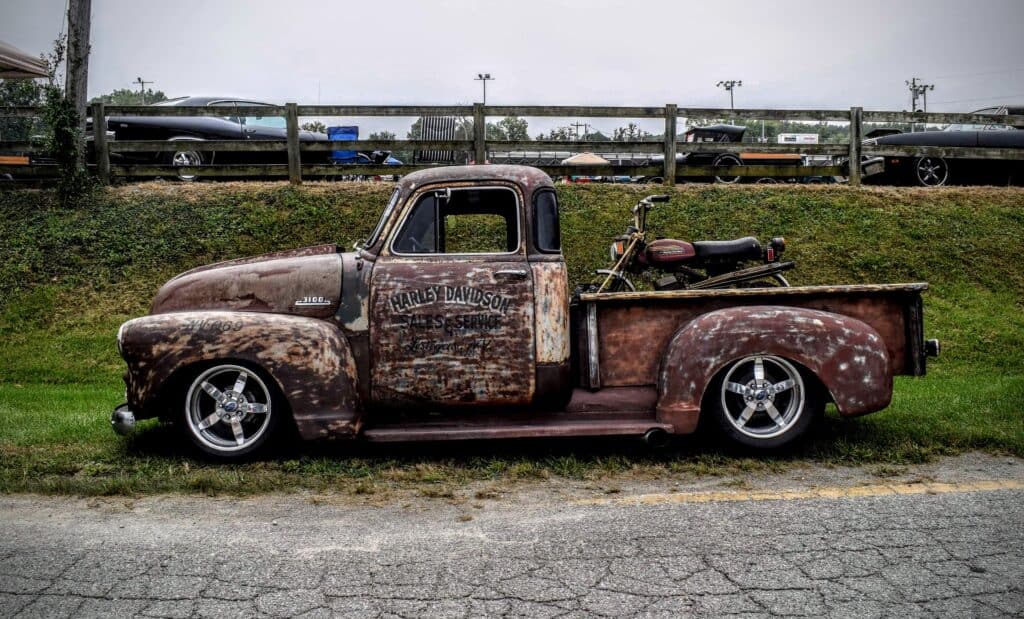
Photo Credit: Micah Wright
How Rust Starts
Every year rust gobbles-up billions of dollars in automotive repairs in the United States alone, and 90% of the time road salt and deicers are to blame. These wintry road deicers may make driving a lot safer, but they are also notorious for causing rust to form on automobiles.
Many of the more severe cases of "vehicle rot" are the result of years of contact with magnesium chloride (MgCl₂), or sea salt. Not only is this salty stuff inexpensive, readily available, and an absolute beast when it comes to thawing-out frozen precipitation, it's also a real bastard for exposed metal surfaces.
When magnesium chloride encounters the right blend of moisture and oxygen, it can cause all kinds of cancerous lesions to form on your vehicle's exposed underbelly. This led us to draft-up an article that focuses on corrosion prevention, and how ceramic coatings can help reduce the risk of rust build-up.
“Rust formation is kind of like spending quality time with your uncle at the local strip club. For this electro-chemical process to occur, you will need an electrolyte (a big bottle of booze), a cathode (a G-string that's hungry for attention), and a generous anode (your drunk uncle) who is willing to stuff electrons (cash) into aforementioned cathode.”

Does Undercoating Prevent Rust?
Coating undercarriage cannot prevent rust but significantly limits its growth and production. Here's how:
1. Barrier Against Moisture and Salt
The undercoating forms a protective layer that keeps debris, road salt, and moisture away from the undercarriage. These elements cause rust by encouraging corrosion. Undercoating limits the contact between these elements and bare metal.
2. Protecting Hard-to-Reach Areas
Some undercarriage parts, which collect moisture and debris, can be challenging to clean and maintain. When applied properly, undercoating can penetrate these cracks and give an extra layer of protection.
3. Sacrificial Layer
Some undercoating formulas function as a sacrificial coating. It corrodes before the metal beneath it. This gives the car more time before rusting begins.
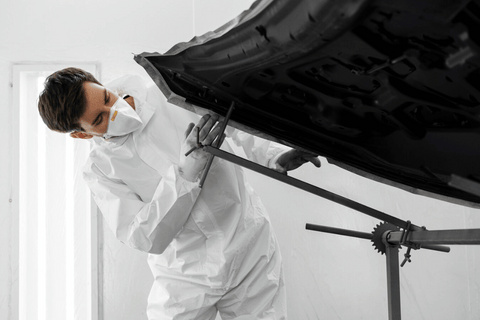
How to Prevent Rust From Spreading
Professional rust formation explanation out of the way, we now turn toward the act of interfering with this corrosive molecular catastrophe.
How to Protect Undercarriage From Rust
Here’s how you can prevent your car’s undercarriage from rusting or corroding:
- Wash frequently using a high-pressure washer or a specialty undercarriage cleaner (especially in winter/salty regions).
- Inspect regularly for rust on the suspension, frame, and exhaust.
- Remove mild rust. Sand the afflicted parts, then use a rust converter for deeper corrosion.
- Pick a high-quality undercoating product suited to your environment and driving circumstances.
- Clear the drain plugs to prevent water from collecting and rusting.
- Seal any exposed metal with touch-up paint to avoid rust.
- Seek professional advice for serious damage or difficult-to-reach areas.
Coat Where the Sun Don't Shine
Coating solutions are intended to block electrolytes from penetrating metallic surfaces, may it be road salt, acid rain, run-off on the roads, or some other form of liquified sludge.
The trick here, is using a coating that actually works as intended, and then making sure that every square centimeter of your vehicle's nether regions gets covered. All it takes is one missed spot and ZINGO! You've got rust...
What About Electric Shock Therapy?
Utilizing an "electric shock" method, like the one previously mentioned, means relying upon an electrical current to prevent the anode from circulating electrons. The basis here is that if you continuously charge the metal itself with a negative current, it can’t throw electrons the cathode's direction, thus preventing corrosion from occurring in the first place.
This approach is designed to be a permanent solution, and one that does not need reinstallation or routine servicing. The only issue is that reviews show that it really doesn't work as well on automobiles as opposed to say, tug boats, and the kits are also quite expensive.
How Long Does an Undercoating Last?
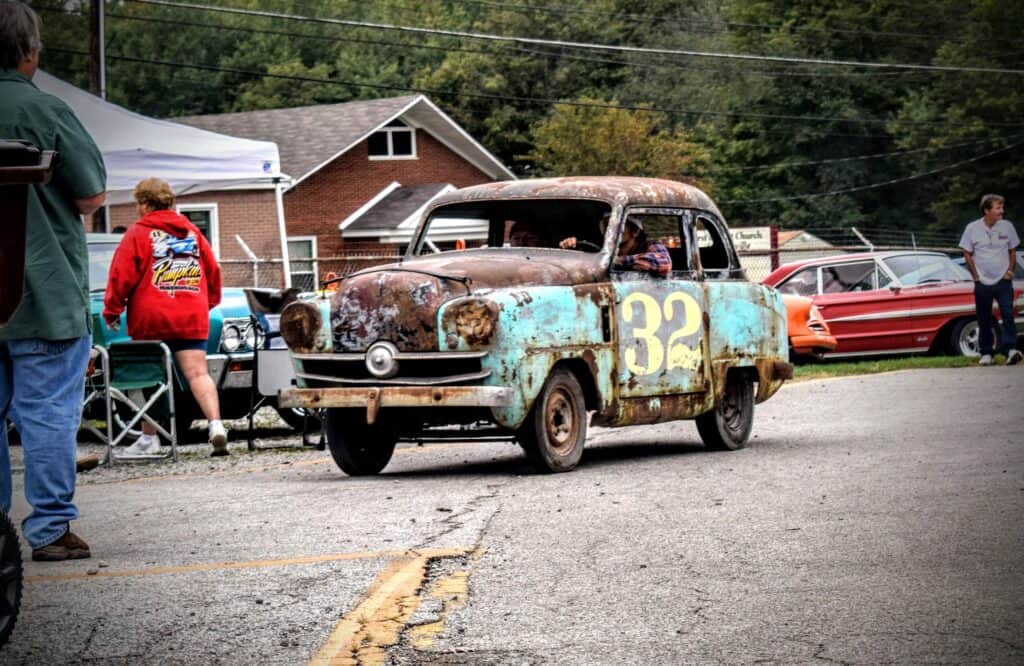
Measuring an undercoating's longevity means factoring-in the environment where the vehicle is being driven, types of deicer and/or salt used on the roads, quality of undercoating utilized, and how thoroughly said coating has been applied.
In short, there is no guaranteed timeframe when it comes to automotive undercoating life expectancies. We've seen multiple reports of undercoatings only lasting a single winter season, while other drivers have reported a decade of maintenance-free use between coatings.
Quick Tip: Routinely washing the underside of a vehicle goes a long way toward extending the lifespan of an automotive undercoating, especially in environments where road salt is used in winter.
Factors Affecting the Lifespan of Undercoatings
As unfortunate as it may sound, you can't predict how long your undercoating will endure. It's a collaborative effort between the type you select, the environment it's in, how you drive, and how well it's applied.
Oil-based alternatives require annual touch-ups, but rubberized or polyurethane can last 5-7 years. However, harsh winters, salty roads, and off-road escapades can shorten their life. The same is true for regular car washes and, of course, if the job was not done correctly the first time.
Nevertheless, a good undercoating is the most recommended protective layer for your car's underbelly. Treat it well, and it will protect you for a long time.
Signs that Indicate Reapplication is Needed
If your undercoating starts showing hints of wear and tear, like cracks, peels, or flaking, it may be time to reapply. Even rust patches in relatively small areas suggest the protective barrier is deteriorating. Increased vibrations or road noise could also point to underlying issues in the sound-dampening properties of the undercoating.
Finally, look out for dampness beneath your vehicle, particularly around seams or crevices. This dampness means you have weak undercoating and potential rust concerns on the rise. To sum it up, if your undercoating isn't looking good or isn't doing its job, it's time for a new coat.
Vehicle Undercoating: Pros and Cons
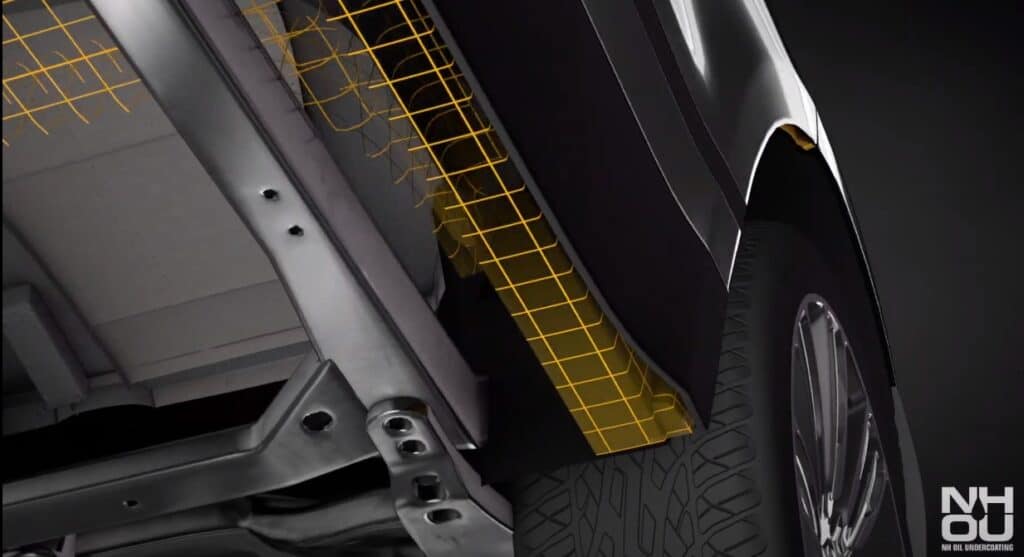
Although the undersides of new vehicles come shielded straight from the factory, those living in cold-weather regions, or areas along the coastline, may require additional undercoatings. But what are the downsides to this stuff, if any? And does an undercoating's perks outweigh its cons?
Undercoating Pros

Photo Credit: AMMO NYC/YouTube
1. Saves from Rust & Corrosion
The biggest advantage of undercoating is knowing that your vehicle is protected from rust and corrosion to an extent. While there are no guarantees that a rust bubble won't appear where a rogue rock chip hits your freshly applied coating, most vehicles go years without requiring a touch-up.
2. Decreased Road Noises
Undercoatings add an extra layer of sound-deadening insulation to the underbelly of a vehicle. It may not be as effective as a dedicated sound-proofing product and it won't do much when repelling heat and cold. Nevertheless, undercoatings greatly reduce road noise.
3. Defense Against Rogue Road Debris
Your vehicle's undercarriage often comes in contact with different kinds of road debris while driving. These are known to chip paint, damage fragile components, and even create entrance points for rust. A properly applied undercoating absorbs minor impacts, protecting sensitive areas from the abrasive effects of road debris.
4. Enhancement in Vehicle's Resale Value
Yes, a damage-free undercarriage will significantly raise your car's resale value. Here’s the deal: prospective buyers realize the value of rust prevention and are willing to pay more for a well-maintained car. A properly applied undercoating shows your commitment to preventative maintenance and extending the vehicle's life.
5. Extended Lifespan and Durability of the Underbody
Moisture, road salt, and severe temperatures can all damage your car's underbody. By acting as a sealant and preventing moisture ingress and corrosion, undercoating prolongs the life of key underbelly parts. This way, you get a longer-lasting car with minimal ownership costs.
Undercoating Cons

1. Talk About Some Seriously Toxic Stuff!
Like many chemical-rich products, the average undercoating is a gateway to organ failure, cancer, infertility, and genetic defects. After doing a bit of digging, we discovered that quite a few brands don't even know what this stuff will do to the human body, with some of the more discerning case studies showing that "...25% of the mixture consists of ingredient(s) of unknown acute toxicity."
So spray safely, and always wear a ventilation mask, protective eyewear, gloves, and a painter's suit when working with undercoatings.
2. Something Smells B-a-a-a-a-a-a-d...
D-a-a-a-a-a-d jokes aside, there's a reason why Lanolin is called "wool grease." This waxy substance is derived from a naturally occurring gland secretion found in fluffy animals like sheep.
It is within these hair follicle glands that lanolin exists. A sticky secretion that provides cud-chewing critters like the ultra-fluffy Merino breed of sheep with a waterproof coat that keeps them dry and warm in winter.
On the downside, because lanolin is basically a livestock secretion, it smells sort of like... well... stank-ass sheep glands. This repulsive aroma is even more notable when lanolin is exposed to warmer temperatures too. So if you notice that no one is parking next to you in summer, it might be because they can't stand the stench of your undercoating.
3. A Not-So Shocking Surprise
Over the years, electronic rust inhibitors have seen a surprising amount of success in both marine and underground structural applications. But as AutoGuide illustrates, the effectiveness of these products depends heavily upon a multitude of factors, many of which are not always present in automobiles.
Most metals do a damn good job of conducting electrical current, which explains why having a module attached to a car battery, with electrodes channeling electricity throughout its frame seems like a brilliant idea... right? Wrong. The following quote explains why this technology doesn't work well on automobiles.
“Electronic rust protection works, though it’s designed for applications like underground fuel tanks and large boats... in those applications, the metal exterior surface is always wet or damp, allowing the signal to conduct powerfully and fully throughout the metal structure..."
-AutoGuide
4. The High Price of Vehicle Undercoatings
But perhaps the biggest complaint people have about automotive undercoatings and rustproofing procedures, is how much they cost. This is precisely the reason why many people opt to take matters into their own hands, and attempt to undercoat their automobiles on their own.

How Much Does Undercoating Cost?
The cost of undercoating a vehicle, whether a car or a truck, varies dramatically depending on several factors. Here's a detailed breakdown:
How Much Does Undercoating a Car Cost
The cost of undercoating a car can range anywhere between $150 to $500. The costs depend on these factors:
- Your vehicle's size.
- The type of undercoating used.
- Whether you DIY or hire a professional.
- Local market rates.
Small automobiles with simpler undercarriage and DIY applications will be less expensive. However, high-performance undercoating and professional services will be more expensive with larger vehicles.
How Much Does it Cost to Undercoat a Truck?
The cost to undercoat a Truck is higher than that of a car, regardless of whether you hire a professional or do it yourself. Professional applications can cost anywhere from $500 to $1200.
However, a DIY application costs between $100 and $200 in materials. Despite the cost savings, DIY projects still involve the same factors as cars: the right tools, spare time, and some know-how to do the work correctly.
How to Apply a DIY Undercoating or Rust Proofing Spray
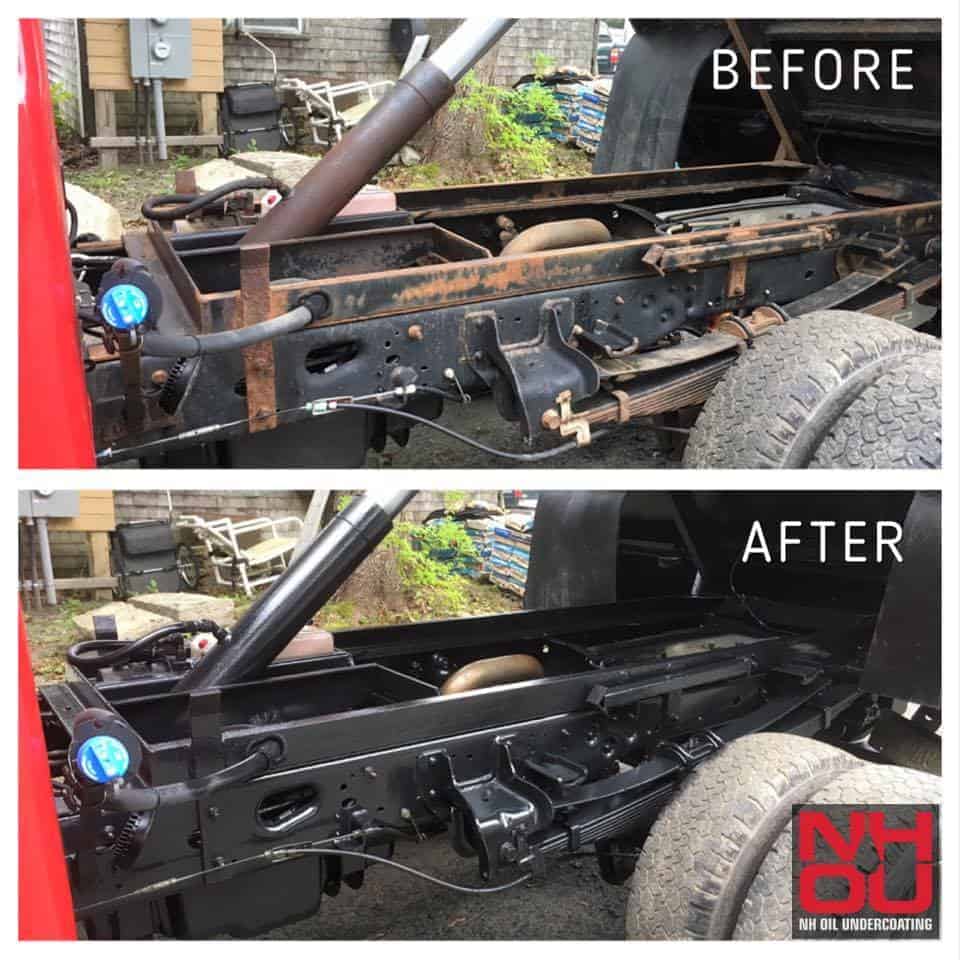
Photo Credit: NH Oil Undercoating
So by this point, you might be thinking, “Well shit, I can save some dough, and do this myself!"
Awesome idea amigo. But before you begin, there are several DIY tips and products you should probably procure prior to applying a rustproofing or prevention spray on the undercarriage of your car.
Undercoating applications can get really messy, really quick, and if you screw up the undercoating procedure, your vehicle could be out of service for a few days. Also, being that this procedure is both labor and time intensive, you will need to factor the whole "time is money" side of things into the equation as well.
But if you crunch the numbers, and it all adds up, then the following items should be procured prior to undercoating your car.
Materials Needed to Undercoat a Car
- Degreaser products
- A disc grinder and replacement pads in varying levels of abrasion
- Power tool with wire brush
- Air hose
- Eye, nose, and hand protection
- Sandpaper (200, 300, and 400 grit)
- Sharp metal scraper
- Undercoating and any required application tools/products
- Car lift
The Undercoating Process
1. Clean
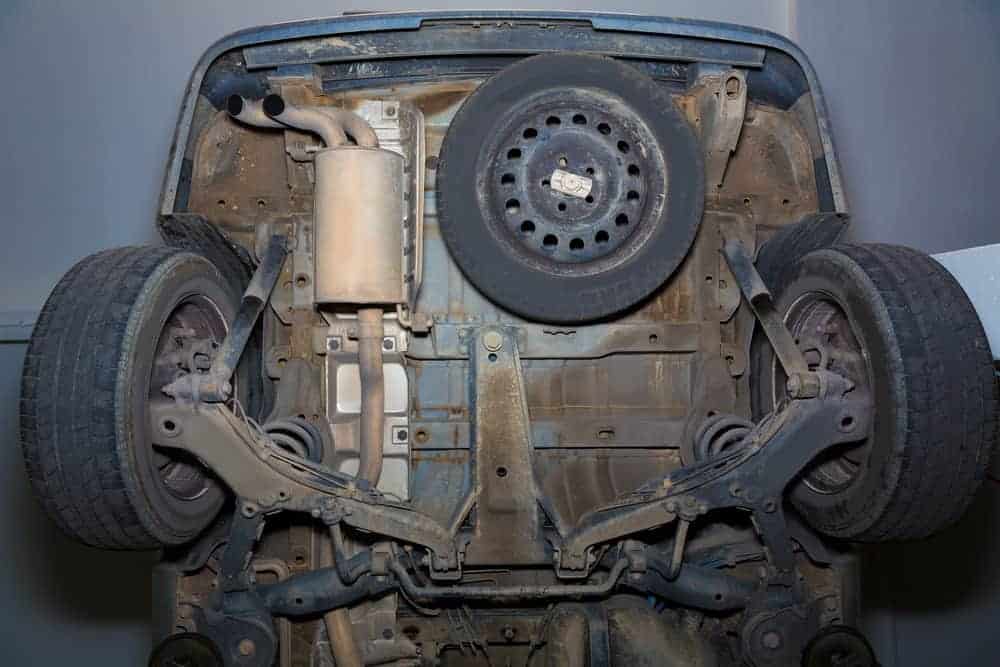
Prior to applying a rust-repelling undercoating, you will need to remove as much corrosion build-up, caked-on road grime, and any other form of "crap-tastic" contaminant from the underside of the vehicle.
Here are a few of the core steps to completing this process.
Blast- Spray the entire underside of the vehicle with either a pressure washer, or a garden hose that has been outfitted with a heavy-duty spray nozzle. Be thorough, and hit every crevice and corner you can find, especially on higher mileage vehicles. Chances are you will be amazed by how much road gunk you will dislodge.
Degrease- Rinse complete, and undercarriage allowed to dry, it's time to use a commercial-grade degreaser to remove any grime or oil lurking beneath the vehicle. The spray and walk away stuff allows you enough time to go get another beer, before removing the degreaser with shop rags or a blast of water.
Grind- The next step is to grind any large chunks of rust or hardened contaminants, starting with a mild grinding pad, and gradually moving to more abrasive pads as necessary. You can also use a stiff wire brush attachment on a power tool or a paint scraper, just beware of any electronics or hydraulic lines that could be damaged by these tools.
Sand- Corroded crap and contaminants blasted and scraped away, break out the sandpaper and get to hand scrubbing that underbelly. Start with a 200 grit sheet, and after each pass move a milder grit of sandpaper. This will not only remove any stubborn rust patches, but it will smooth out the scratches left behind by the coarser forms of scouring media.
IPA Time- No, we're not talking about beer, even though suds and scrubbing do tend to go hand-in-hand on a hot summer day. We're talking about using an isopropyl alcohol (IPA) blend and dry rags to wipe-down what will be getting undercoated. This final prep process helps ensure that the entire undercarriage is devoid of dust and other gunk.
2. Prime Time!

Most DIY undercoating products require a primer of some sort to serve as a basecoat. We've found that the best primers are those with high zinc levels, as this provides an additional corrosion resistance. Just be sure to follow the manufacturer's instructions, for many primers have their own unique prep requirements and curing times.
3. Undercoat
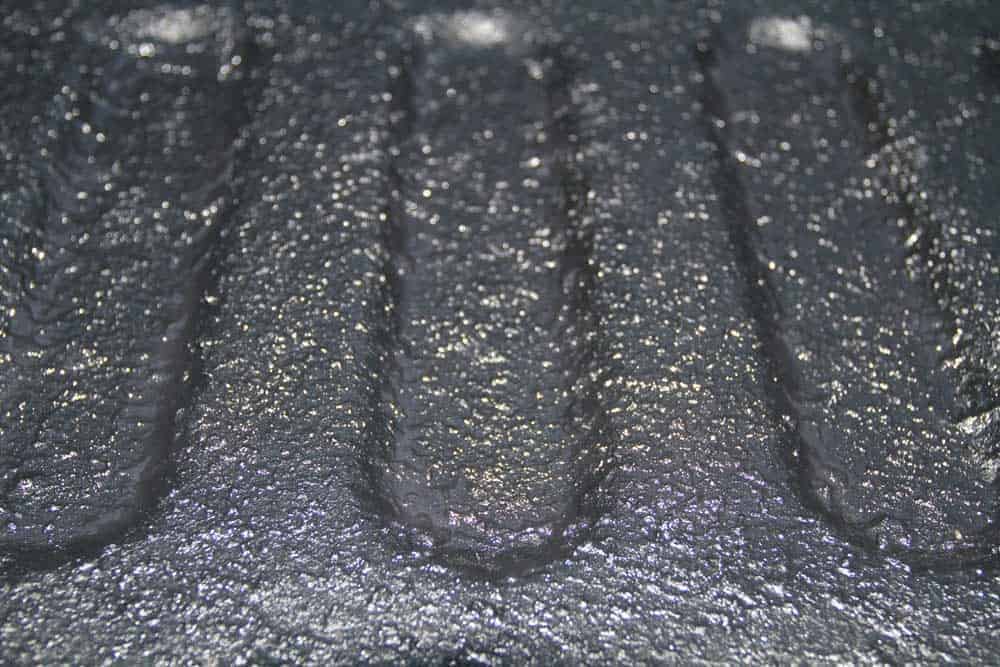
The final step in the undercoating process is the application of the undercoating itself. Most of these products involve a two-stage or dual-layer spray-on procedure.
While the first round of undercoating should be relatively thin, know that it is not there to be the first line of defense, but to serve as a basecoat for the thicker outer coating. An hour or two of downtime on a warm day should provide ample cure time for this first layer. Once it becomes tacky to the touch, it's time to move on to the final outer coating.
These final layers should be applied liberally, and in smooth, slow movements. Rushing will only cause uneven coverage and drips to form, so take your time. Once fully coated, it's time to sit back and let your undercoating cure, which depending upon temps and the product used, may take anywhere from a few hours to a few days.
How to Undercoat a Truck
Here’s our 5-step method to undercoat a truck like a true DIY professional:
Step 1: Pre-application Underbody Prepping
First, scrub your undercarriage well with a degreaser. Use a wire brush or scraper to remove any debris. Once everything is clean and dry, use plastic or tape to protect the brake lines, exhaust components, and electrical parts.
Finally, gather your preferred undercoat (rubberized asphalt, polyurethane, or lanolin-based) and application method (aerosol can, sprayer, or gun).
Step 2: Covering Hard-to-Reach Areas First
Using extension nozzles or probes, apply thin, even coats to frame rails, inner fenders, and crevices. Wait for each layer to dry slightly before adding more.
Step 3: Target Your Underbody’s Vulnerable Areas
Turn your attention to the rocker panels, wheel wells, and beneath the splash guards. These locations are the most susceptible to moisture and salt damage. Apply extra coatings as needed.
Step 4: Prevent Overspray at All Costs
Maintain a safe distance from non-damaged components to prevent unwanted coating. Use a solvent-soaked rag to wipe up any accidental over-spray promptly.
Step 5: Apply Multiple Coats for Long-Lasting Defense
Apply 2-3 coats for maximum protection depending on the product and desired thickness. Allow sufficient drying time between each application, as specified by the product.
Can You Protect Other Car Parts From Corrosion?
If you’re looking for a long-lasting solution for preventing body panel rust and surface corrosion, opting for a nano ceramic coating is the way to go. 9H-rated ceramic coatings in particular are quite good at repelling rust.
Utilizing a highly-concentrated liquid polymer that's been enhanced with liquid quartz, a.k.a. silica dioxide (SiO2), nano ceramic coatings seep into clear coats, chrome, bare metal, and other porous hard surfaces.
Once cured, nano ceramic coatings create a completely transparent, ultra smooth crystallized surface. This layer of protection repels everything from UV rays and acid rain, to bird droppings, tree sap, surface scratches, and the damage caused by most road chemicals.
Higher end ceramic coating for cars, like Armor Shield IX, also have the ability to reject electrolytes, therefore preventing them from penetrating surface areas, and thus, reducing the potential risk of corrosion.
How to Remove Undercoating
Undercoating removal is often necessary for prepping for repairs, repainting the undercarriage, or seeking a fresh start.
Nevertheless, it's not a simple or quick task, either. Its intricate methods require serious precautions — here's how to do it:
Mechanical (Physical) Method
Usually, the most intense method is to use tools like wire brushes, scrapers, and chisels. It works well for thick or heavily adherent undercoatings. However, if not done right, it can damage underlying surfaces.
Heat (Insulation) Method
The undercoating becomes softer and simpler to scrape or peel off when heat from a heat gun/torch is used. Practice this method carefully and with the right ventilation to prevent burns and fire threats.
Chemical (Stripping Agent) Method
Stripping agents are available in many forms, including gels, sprays, and pastes. These chemicals dissolve or soften the undercoating. Because of their potential toxicity, some products require proper disposal with extensive safety precautions.
Parting Shots

Photo Credit: Micah Wright
Having an automobile treated with an undercoating is not only a smart way to extend the lifespan of the vehicle, but it also protects crucial brake and suspension components from seizing due to corrosion.
When properly installed, an automotive undercoating also has the power to keep an undercarriage shielded from all sorts of unsavory shit. This means everything for saltwater, deicers, road grime, engine oil, corrosive chemicals, and many other kinds of corrosion-causing contaminants get kicked to the curb.
However, it is still imperative that that you routinely wash your automobile (and its underside) with a pH balanced shampoo. Embedded contaminants will always do their damndest to wreck your ride, so break out that "winter coat" and don't forget about the shiny topside, because it too is prone to rust and corrosion.





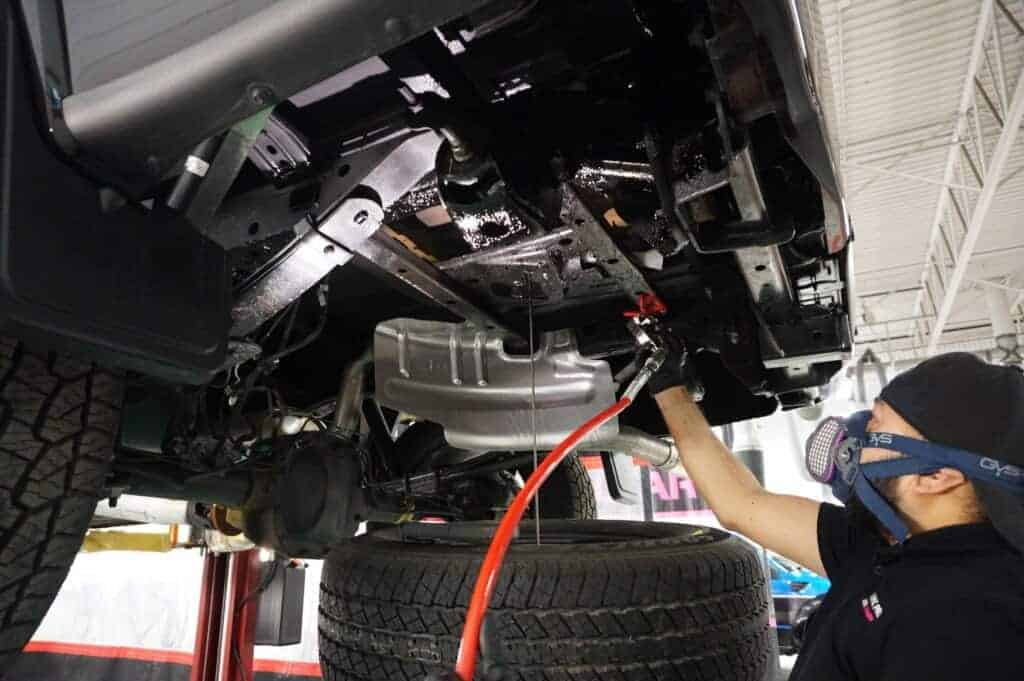





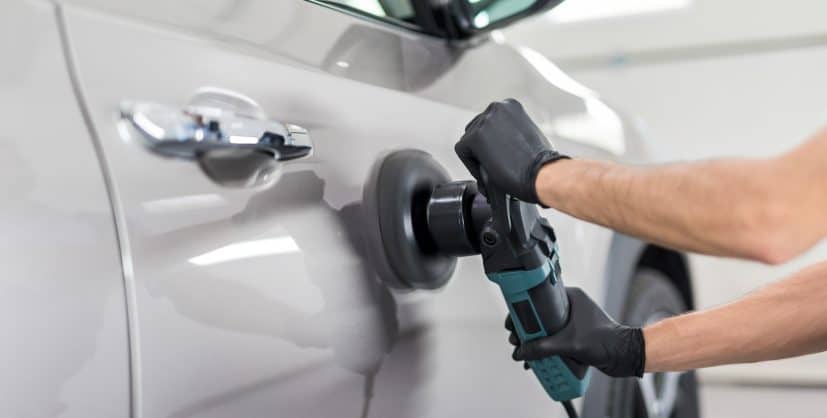

25 comments
Brittany R.
I am about to purchase A 2020 Toyota C-HR. Should I have it under coated? The dealer said it would cost an additional $600.00. What would you suggest do?
I am about to purchase A 2020 Toyota C-HR. Should I have it under coated? The dealer said it would cost an additional $600.00. What would you suggest do?
Mark D
I just bought 2013 Ridgeline. Is it worth having an oil based undercoat/rust inhibitor applied.
I have a quote for $300
Thanks
I just bought 2013 Ridgeline. Is it worth having an oil based undercoat/rust inhibitor applied.
I have a quote for $300
Thanks
Jackie
I am looking to buy a Cadillac SUV that has been in Canada, a 2016. Perfect condition except rust underneath. Should I just keep looking? I like the vehicle, if I could get a good amount off would it help to do an undercoating now or is it too late?
Thanks!
Jackie
I am looking to buy a Cadillac SUV that has been in Canada, a 2016. Perfect condition except rust underneath. Should I just keep looking? I like the vehicle, if I could get a good amount off would it help to do an undercoating now or is it too late?
Thanks!
Jackie
Dale Pearl
Hi Tim!
Probably not but impossible to answer without actually seeing what is going on. At the very least the undercoating would help to slow down and help mitigate further issues.
Hi Tim!
Probably not but impossible to answer without actually seeing what is going on. At the very least the undercoating would help to slow down and help mitigate further issues.
TimR
I’m looking to buy a 5yr old vehicle that has spent its entire existence in Alberta, Canada. Has the vehicle had too much exposure to road salt for an undercoating to do any good at this point?
I’m looking to buy a 5yr old vehicle that has spent its entire existence in Alberta, Canada. Has the vehicle had too much exposure to road salt for an undercoating to do any good at this point?
Dale Pearl
Hi Daniel!
Fire over a direct email to us and we’ll try to help you find a detailer in your area that may be able to help you out!
Hi Daniel!
Fire over a direct email to us and we’ll try to help you find a detailer in your area that may be able to help you out!
Daniel
Have my land rovers discovery 1 come to the east coast, who or what would be the best undercoating you would suggest and some place near NYC like NJ or CT where I can get it done?
Have my land rovers discovery 1 come to the east coast, who or what would be the best undercoating you would suggest and some place near NYC like NJ or CT where I can get it done?
steve
Get an oil based coating. it will make maintenance messier, yet easier.
Get an oil based coating. it will make maintenance messier, yet easier.
Bob
I have a 4X4 I’m thinking about having it professionally under coated, my question is after the undercoating is it more difficult to do maintenance work, like removing bolts or screws or things like that because of the thick rhino lining type coating?
I have a 4X4 I’m thinking about having it professionally under coated, my question is after the undercoating is it more difficult to do maintenance work, like removing bolts or screws or things like that because of the thick rhino lining type coating?
Tim Charlet
Hi Wendy:
Thanks for the question – it’s a good one. Newer cars, trucks, and SUV’s are made from higher-quality products that are corrosive resistant. However, living on the coast and in a region where you get a lot of snow – and there is road salts or mag chloride used, it’s always a good peace of mind to have the coating added. Every year might be a bit of overkill, but if it’s in your budget, it won’t hurt to have it done.
Hi Wendy:
Thanks for the question – it’s a good one. Newer cars, trucks, and SUV’s are made from higher-quality products that are corrosive resistant. However, living on the coast and in a region where you get a lot of snow – and there is road salts or mag chloride used, it’s always a good peace of mind to have the coating added. Every year might be a bit of overkill, but if it’s in your budget, it won’t hurt to have it done.